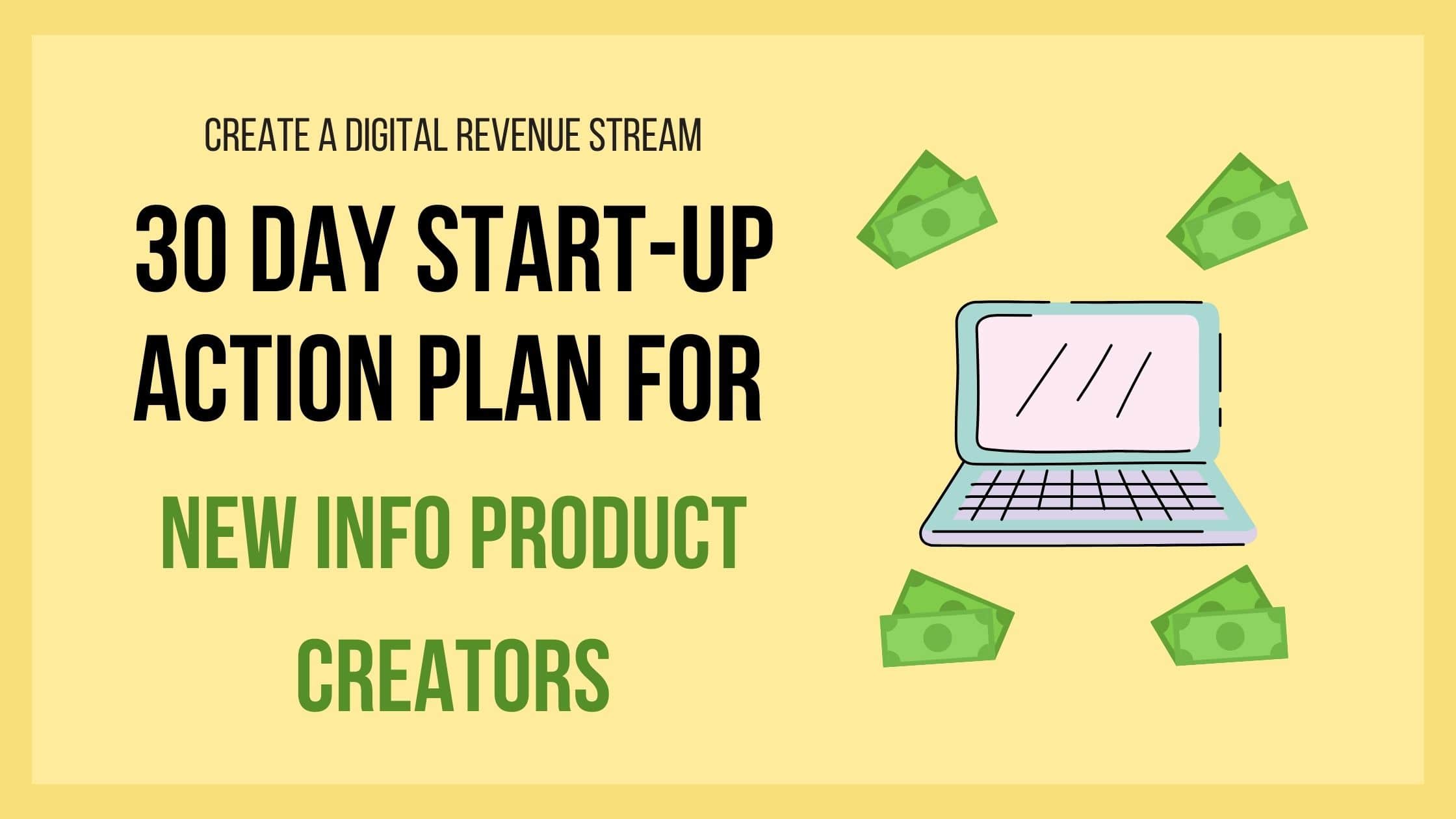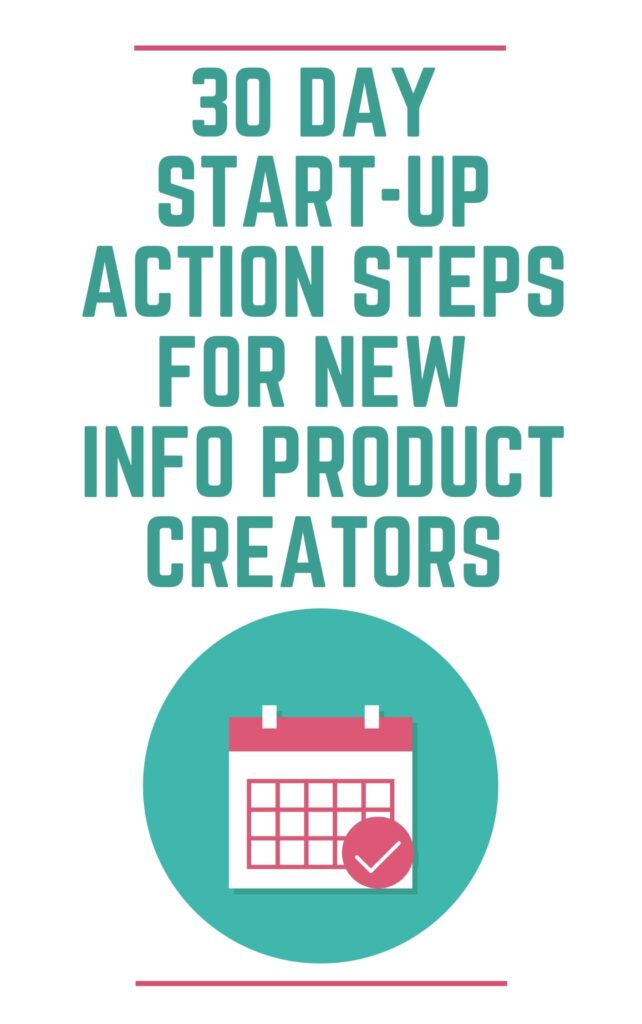Thinking about launching an info product in the coming year? In this post, I’m sharing a 30 Day Start-Up Action Plan for New Info Product Creators.
30 Day Start-Up Action Steps for New Info Product Creators
If you’ve dreamed of having a work at home career as an online entrepreneur, you may want to consider the role of a digital info product creator. Digital courses have long been in high-demand, and consumers keep shopping for them.
No matter which niche you’re in, there’s a strong likelihood that there’s a need for instant and downloadable courses that can inform, educate and guide users in the best way to achieve a certain goal or find a solution to a problem.
Below, you’ll find a simple, 30 day action plan where you’re given one task per day to completion each week, with a single day off to rest. If you feel like doubling up on a few tasks, you can complete it sooner.
Week 1: Analyzing the Marketplace to See What’s Selling
Before you can begin a career as an online digital vendor, you need to know what consumers are purchasing in the marketplace so that you can ensure that your product stacks up to the very best.
Day 1 – Visit ClickBank to Check Out the Bestsellers
The first stop you may want to make is to ClickBank. This is an online digital and tangible marketplace for products in a wide variety of niches. They are a little more strict in what they allow, but this is a good thing because consumers feel a sense of safety.
Go to the marketplace and look at the categories on the left hand side that may match your niche. You will be able to see what is ranking as a bestseller, what the price points are, and how many affiliates are earning money promoting the software based on the gravity statistic.
Day 2 – Take a Look at Warrior Plus to Find Out What’s Hot
Warrior Plus is another digital marketplace that you will want to visit to see how products are ranking in terms of popularity among consumers and affiliates alike. Here, you can actually look at how a funnel unfolds in terms of what is presented and in what order, along with the price points.
Day 3 – Check Out JVZoo to See What’s In-Demand
Next, go to JVZoo and to see what is in demand on that digital marketplace. you can look at both current and past product launches to see how many were sold and what the conversion rate was.
Day 4 – Look on Udemy for Courses That Sell Well
You can also go to Udemy and see which courses people are buying and ranking well. Under the listing, you will be able to see the price point of the course, a short description, its star rating, and the total number of hours and number of lectures included.
Day 5 – Head Over to Amazon to See What’s Popular
Make sure you also check out Amazon’s bestselling book list. You can specifically look at your niche topic and see what patterns you notice about popular topics, such as mindset or habit changing.
Day 6 – Look on Social Media to See What the Chatter Is
Social networking sites and apps, as well as forums, will have consumers actively engaging in discussions about their problems that they’re seeking solutions and advice for. This will help ensure you’re meeting the needs of the consumers who you want to buy your upcoming product.
Week 2: Mapping Out Your Info Product
Once you have some ideas about what the marketplace is demanding, you will want to start the process of mapping out an info product of your own. You never need to worry about a topic having been done before.
The only thing you need to focus on is that you deliver value and accurate information to your customers. Even if you are teaching the exact same thing as someone else, they may have a personal preference for you as a teacher or for the media format that you are using.
Day 7 – Come Up with a Slant for Your Product
The first thing you want to do is come up with an overall slant for your product. For example, if you are teaching the topic of blogging, you may have slants such as blogging for seniors or mommy bloggers, or blogging as a side hustle for extra income.
Day 8 – Break the Topic Up Into Sub-Topics
Next, create an outline for your overall product. Make a list of all of the main things that you want to teach in your course. If you want to, you can also create a list of what will go in each of those sections or modules.
Day 9 – Consider What Media Format to Use
On day nine, you will be tasked with making the decision of which media format you feel will work best for your target audience. If you use text, and you need to show steps, you will have to create screen capture images.
Using video, you can simply record in an over the shoulder type of screen capture so that they can see what you are doing in a step-by-step manner. You may want to make your decision based off of what is already in the marketplace.
If you see a lot of video, it could mean that your specific topic requires video. However, it could just be the personal preference of the vendor, in which case a text alternative may go over well in the marketplace.
Day 10 – Brainstorm One or Two Upsells
Part of the product planning stage will be for you to determine what all will be in your funnel. Ideally, you will have at least one or two upsell offers so that your customers have the opportunity to receive more value from you, and your affiliates have additional opportunities to earn commissions.
Day 11 – Determine Your Price Points
After you know what will be in your funnel, you need to set a price point for every portion of it. Usually, the price points climb upward. For example, you may start off with a $17 front end product, followed by a $27 one time offer upgrade, followed by a $47 second one time offer upgrade.
You may have a high ticket offer in there as well, such as coaching, that you put as the final one time offer upgrade. Or, you might even do a free front end offer and more expensive one time offer upgrades in an effort to help build your list.
Day 12 – Consider Running a Contest for Affiliates
Take today to make a decision about whether or not you’re going to host a contest for your affiliates. Never promise to pay out prizes you can’t afford, and set minimums to ensure that someone who only makes 5 sales can’t win an expensive first place prize.
If you want to, you can visit Warrior Plus and see what contests have been run or are coming up so that you’ll know what’s common for prize money as well as how it’s earned, such as the volume of sales or revenue earned.
Week 3: Set Up Your Product Listing and Announcements
Before you even begin creating your product, you want to create the listings and launch announcements so that affiliates can begin getting ready for it well in advance. They will want to have time to schedule a promo for your lunch as well as create a bonus that will help them earn more commissions and dominate the leaderboard.
Day 13 – Set Your Launch Dates and Times
You need to spend today coming up with a feasible timeline for your launch. Ideally, you want to give affiliates at least two weeks after you announce the launch to work on their promo efforts.
You also want to select a date that isn’t crowded on product launch calendars, if possible. Give yourself more than enough time to complete the product. You don’t want to be rushing and have to cut corners with quality or delay your launch due to unexpected obstacles.
Day 14 – Create Your Product Listing and Funnel Where Applicable
Take today to decide where you want to list your product for sale. You can always list it on multiple platforms for the launch, but honestly, this diminishes the volume of sales people will see on each site and it might be best to stick to just one.
Day 15 – Set Up a Joint Venture Details Page
On day 15, you want to create your JV (joint venture) page that will inform your prospective affiliate marketers about the details of your upcoming launch. On this page, you need to have the dates and times of your launch, details of what is in each part of your funnel, the price and commission percentage you are offering, swipe files for them to use in their email promos, and buttons to where they can go grab their affiliate links.
Day 16 – Head to MunchEye and Make Your Launch Known
Once your JV page is set up, go set up an account on MunchEye.com, which is where online marketers go to list their product launch. Here, affiliate marketers can find products that they wish to promote.
Each of the listings is like a blog post, so you can format the details that you provide just as you would on your JV page. Each week, the products that are launching will also be listed in a forum that they run, so you will get additional coverage to prospective affiliates.
Day 17 – Announce the Upcoming Launch on Your Social Media Profiles
After you have completed that step, go to your various social media profiles, where you should be networking with other marketers, and announce your upcoming launch. Make sure you include a link to the JV page as well as a few small details about what your product is about.
Day 18 – Reach Out to Recruit a Few Select Affiliates
Once you have done that, take some time to research past product launches that had contests and leaderboards, and take note of who was able to convert visitors into buyers.
After you have this list, you can go and contact these select individuals and hopefully recruit them to promote your launch. Make sure you approached them with a link to the JV page as well as a complimentary review copy for them to consider.
Week 4: It’s Product Creation Time
During week 4, you will be working on the creation of your product. You may have even already started, and it may take you more than a week. Don’t rush the process. If it takes you three weeks instead of one, it’s better to have a quality end result.
Day 19 – Create the Front End Product
On day 19, create the front end of the product that you want to sell. This may be something like 10 video modules with accompanying PDF transcripts, or a 25 page eBook.
Everyone who is creating their own products will be doing so at a speed that is right for them. Some people may be able to create right 40 pages a day, while others can only write 5.
Day 20 – Create Your Upgrade Offer
After creating the front end product, it will be time to work on your upgrade offer. This may or may not take one day, and you may have more than one upgrade offer. If so, feel free to stretch out the time as much as you need without delaying due to procrastination or fear.
Day 21 – Write Your Two Sales Letters
When the product has been created, you will need to log in to your domain and create two or more sales letters, Depending on how many upgrades you have. The sales copy will vary a bit, because with the front end copy, you are trying to convert a visitor who has obstacles with buying.
After they have proven that they can let their barriers down and purchase from you, the sales copy for your one time offer upgrade should be easier to write. This is an offer where you are simply trying to elevate and add value to the customer’s original purchase.
Day 22 – Make a Strategic Download Page
On day 22, you want to take some time to create a strategic download page. Many people missed the mark with their download page, simply including a link for the customer to download their product.
However, the space on this page can be used to increase your earnings by reminding buyers to consider the upgrade offers, introducing them to other products you may have in the marketplace, or even linking out to affiliate offers.
If you want to, you can also offer some of this prime digital real estate to top affiliates that you want to recruit for your launch. You can allow them to send you a banner ad that is placed below the download links and which links out to their products or lead magnet page.
Day 23 – Do Last Edits and Go Above and Beyond
Today, you will be doing a quality check on your own product for any last minute edits that need to take place. Don’t try to rush the process and put out shoddy work. Even though it’s annoying, you need to go back and redo videos that need to be repaired or text that needs to be edited.
You also want to take this time to think of some way that you can go above and beyond to those who buy your product. For example, you may want to come up with a checklist or cheat sheet that you include as a surprise gift in the download.
Day 24 – Send Out Review Copies to Get Feedback
On day 24, take the finished product and send out review copies to affiliates that you want to recruit to your launch. This will help them make a final decision about whether or not to promote you to their subscribers.
You may also want to send a review copy to a couple of your dedicated followers from your blog or social media so that you can solicit feedback to use in your testimonials on your sales page.
Week 5: Last Launch Steps to Consider
This is the last week of your launch. There are a few housekeeping issues to take care of to ensure that your launch is carried out effortlessly. Most people end up extremely nervous during their first launch of an info product.
If you do the following steps, it will help alleviate the nervousness that you feel about putting yourself out there in front of customers as a leading niche expert. You will gain a solid reputation as an info product creator and instill confidence in both customers and affiliates.
Day 25 – Upload Your Final Files
On day 25, take your final files and upload them to whatever platform you are using to sell your product on. If you have received any feedback from prospective affiliates or followers who received your complimentary review copy, take time to make any changes you feel are necessary before you take this step.
Day 26 – Do a Test Purchase to Ensure Functionality
Today, you should be doing a test purchase on the platform that you are selling on so that you can make sure the launch will function properly. Many people fail to do this step, and right when many top affiliates send a flood of traffic, something glitches and sheer panic sets in.
This is a great way to ensure top affiliates will never promote for you again. They expect you to test your launch and make sure that everything is working properly. If they reserved a spot in their email promos for your product, and the link doesn’t work so that they can earn commission, they will be understandably angry.
Day 27 – Create a Welcome Email for New Buyers
On day 27, create a welcome email in your email autoresponder system that greets all of your new subscribers who came from the purchase of your info product. You can segment your email autoresponder lists so that you have a buyer’s list that is separate from those who simply download your freebie on a lead magnet page.
Day 28 – Be on Hand When the Launch Goes Live
Today is the day when your launch will go live. You want to make sure that you don’t simply schedule it to go live while you do other things. You want to be on hand to make sure that the process is running smoothly for both your affiliates and your customers.
That way, if anything goes wrong, such as you forgetting to replace an old file with an updated one, or the website crashing due to the amount of visitors that are being sent to it, you will be able to handle it immediately.
Day 29 – Update Affiliates About the Leaderboard
After the first day of the launch, and until the lunch is over, however many days you choose to let it run, you want to update affiliates about the leaderboard if you have decided to run a contest.
Not only do you want to email them, if you have a separate list for affiliates, but you also want to share the leaders of your contest on social media. Many marketers truly enjoy earning the bragging rights of being a top affiliate, because it helps their business in many other ways.
Day 30 – Have a Plan for the Post-Launch Period
Make sure you have a plan for what happens after the launch is over. What will you be working on next? What have your customers signaled that they are interested in? You also want to plan any reciprocal promotions you have agreed to, hopefully with top quality vendors such as yourself.







